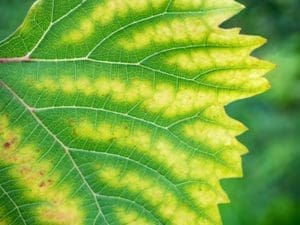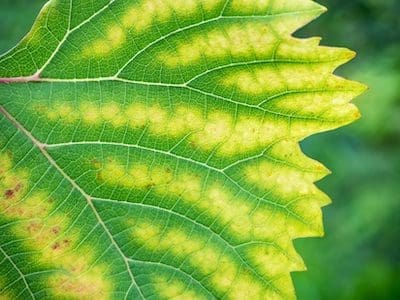In autumn, changing leaves are a seasonal hallmark and source of beauty. But leaves that turn yellow during other times of the year shouldn’t be celebrated. They indicate that the tree is suffering from chlorosis.
While chlorosis has an obvious impact on your tree’s aesthetics, it’s also a sign that your tree is suffering from a nutrient deficiency that may take a lasting toll on the health of your tree. In fact, chlorosis is a major cause of tree decline in the midwest, particularly for pin oaks. That’s why we want to provide you with more information: so you can look out for, prevent, and treat chlorosis amongst your own trees.
I. What Is Chlorosis?
As we mentioned, chlorosis is a condition in which plant leaves turn yellow or become pale in appearance. This is because the plant is unable to produce sufficient levels of chlorophyll, which is the pigment that gives leaves their green hue.
Chlorophyll is also the compound that allows plants to absorb light and perform photosynthesis. As a result, plants suffering from chlorosis are limited in their ability to manufacture carbohydrates and perform basic cellular functions.
II. What Causes Chlorosis?
Chlorosis can be caused by a number of factors. However, in the St. Louis area, chlorosis is most commonly caused by an iron deficiency resulting from soils that are alkaline (pH > 7) and contain lime. This specific soil composition triggers chemical reactions which make iron in the soil solid and unavailable to plants for absorption.
Because of the role that lime-rich soil plays in causing chlorosis, conditions where topsoil has been removed can be especially problematic. That’s because doing so can leave lime-rich subsoil exposed. Examples include eroded soil or areas where the land has been leveled in preparation for construction.
Trees also require manganese to produce chlorophyll. Unfortunately, soils that are alkaline and lime-rich have the same solidifying effect on manganese as they do on iron. As a result, manganese deficiency is another common cause of chlorosis.
In fact, any condition that limits a tree’s access to soil nutrients may result in chlorosis. Plastic sheet mulching, compaction, and water-saturated conditions may all result in chlorosis because they limit the soil’s exposure to fresh air. This results in poor soil quality and low mineral composition.
III. What Does Chlorosis Look Like?
We’ve all seen yellow leaves in the fall. But leaves turning yellow from chlorosis look much different. First of all, they might not even turn yellow; they may simply become pale green and drained of color. Secondly, they typically remain green near their veins. This is commonly referred to as ‘interveinal’ discoloration.
As you can see below, a leaf suffering from chlorosis typically loses pigmentation near the edges first, and they don’t take on the orange or red coloration that we associate with leaves turning in the fall. Typically, new limbs and leaves are the first to be affected by chlorosis.

Chlorosis can look different depending on the tree. Chlorosis may affect only particular limbs or areas of the tree; it’s not always present on every leaf. Furthermore, in severe cases, leaves may turn yellow or brown, and may even fall prematurely. In those cases, the tree may also fail to produce flowers or fruit.
If you’re not sure whether your tree has chlorosis, ask a certified arborist. If they diagnose your tree with chlorosis, you will also need their help with treatment, as determining the exact cause of the condition is necessary – but may be tricky.
IV. How Do I Treat Chlorosis?
To treat chlorosis, it is necessary to change the soil composition. Solidified iron and manganese won’t become available for absorption until this occurs.
It is also necessary to determine how much iron or manganese the tree requires. Too much of either mineral can be toxic to a tree. Your certified arborist can help you determine this amount. Then, he or she will treat your tree with a mineral-rich trunk injection. Our team recommends this approach as long as the tree is still viable.
Note that trunk injections like this need to be administered by a licensed applicator because of the herbicidal nature of the solution. Additionally, DIY treatments with household sources of iron like iron shavings will not benefit your tree, because they are not available for absorption by the tree.
If chlorosis is caused by other conditions, such as over-watering or improper mulching, your arborist can help you identify the source of the problem. He or she will show you which conditions to change, and may also recommend a trunk injection to hasten your tree’s recovery.
V. How Can Chlorosis Be Prevented?
If it sounds like a hassle to treat a tree with chlorosis, you’re right – it’s best to avoid chlorosis altogether.
We should note that trunk injections are used for treatment of existing cases, not prevention. But, there are other preventative steps you can take.
First, if you’re planning to plant a new tree or shrub, have an arborist assess the soil where you’re thinking of planting. They will help you avoid soils that are alkaline or high in lime content. Similarly, if you’re worried about the soil content where you have an existing plant, your arborist can help you assess and correct soil conditions before chlorosis occurs.
Some growth regulators have also proven to be effective at promoting chlorophyll production in plant leaves. Growth regulators have a number of effects on plants, so we recommend discussing this option with your plant care specialist to see if it’s right for your trees.
The Takeaways
If you care about the health of your trees (and if you’re reading this, we figure you do!) it’s important to have some knowledge about chlorosis. We hope that this information will be helpful to you should your tree develop chlorosis, so that you can identify the condition, understand it’s causes, and be prepared to get help.
If you have trees struggling with chlorosis or fear that they are at risk, give us a call. Our team of certified arborists and plant health care specialists will be happy to help.

